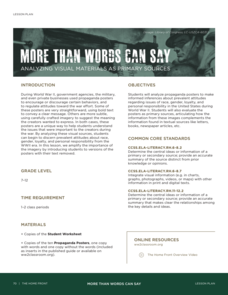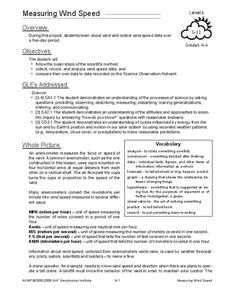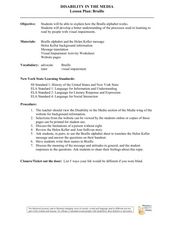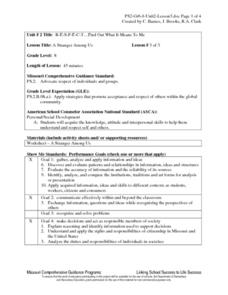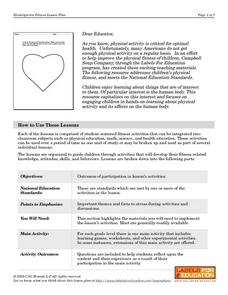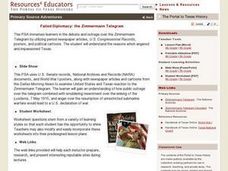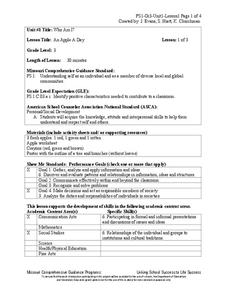National WWII Museum
More Than Words Can Say: Analyzing Visual Materials as Primary Sources
The propaganda of World War II was a key factor in galvanizing the home front. Class members examine images—without their text—to consider their messages, including those around race and gender. Using pictures and discussion questions,...
Curated OER
The Influence of Values on Career Choice
Young scholars examine job opportunities and how things in their lives influence their choices. In this investigative activity students complete a worksheet and several exercises.
National Endowment for the Humanities
Revolution '67, Lesson 1: Protest: Why and How
To some people, protesting is as American as apple pie, but the factors that lead to protests can be as confusing to veteran activists as to today's youth. Revolution '67 explores the riots in Newark, New Jersey as a case study. ...
National Security Agency
Are You Game? A Lesson Connecting Fractions and Probability
Exactly how fair are the board games children grow up playing? Young mathematicians investigate this questions as they work their way through this five-lesson series on basic probability.
Curated OER
Identity: A Path to Self-Esteem
Sixth graders participate in a brainstorming activity in which they identify the types of decisions they make everyday. Individually, they complete a worksheet on making decisions effectively. After reading a poem, they identify the...
University of the Desert
Why Is Cultural Diversity a Positive Thing?
From more empathetic individuals to greater tolerance in government, learners explore the benefits of a culturally diverse world through a series of collaborative, discussion-based activities.
Curated OER
Measuring Wind Speed
Students study wind speed and collect wind speed data. In this wind speed lesson, students visit a website to learn about the local wind speed forecast for their week. Students discuss wind and wind speed. Students collect wind speed...
Curated OER
Disability in the Media Lesson Plan: Braille
Students determine the workings of the Braille alphabet and how people with visual impairments learn how to use it. In this Braille lesson, students study the associated vocabulary, read about Helen Keller, and complete associated...
Curated OER
Chivalry
Eighth graders explore manners by writing short stories. In this chivalry code lesson, 8th graders identify the traits of chivalry and explore the history of chivalry in England. Students complete a chivalry worksheet and write a...
Curated OER
Are You Balanced?
Fifth graders discuss what it means to have balance in their lives. Individually, they are given a worksheet in which they list their activities and things they are involved in. To end the lesson, they place weights on each side of a...
Curated OER
A Stranger Among Us
Eighth graders give their own definition to the terms race, religion, culture, character and ethnicity and write them on the board. As a class, they discuss the differences and similiarties between the terms. In groups, they complete a...
Curated OER
Change the Beat
Brainstorm the reasons why a healthy heart is important. Using a diagram, label and locate the heart and discuss its function. Practice finding your heartbeat and describe the effects of physical activity on the heart. Also perform an...
Curated OER
Radio News
Part of a larger unit from the Media Awareness Network on media literacy, this particular lesson plan focuses on the medium of news radio. Small groups participate in discussions on their radio listening habits as well as the...
Curated OER
Dear Sassy Successful Student
Fifth graders identify the people who are responsible for their success and their current studying skills. In groups, they brainstorm helpful studying strategies and develop a creative way to share it with the class. To end the lesson,...
Media Smarts
Bias in News Sources
As young consumers of media, it is important for high schoolers to explore concepts of bias and prejudice, and how they may be present in media. After discussing ideological messages that media can contain, individuals complete a warm-up...
Curated OER
Failed Diplomacy: The Zimmerman Telegram
Seventh graders continue their examination of World War I. In groups, they read a copy of the famous Zimmerman telegram and discuss its effect on Americans. To end the lesson, they discuss how public opinion changed after it became...
Curated OER
Meeting an Earthworm
Students inspect the anatomy of earthworms. In this earthworm lesson, students participate in a hands-on experiment as they analyze the structure of earthworms. Students demonstrate mastery through differentiated products. Lesson...
Curated OER
An Apple A Day
Third graders brainstorm a list of how they can tell if someone feels bad about themselves. As a class, they describe three different apples shown to them. Individually, they cut out shapes of apples and color them to place them on a...
Career Solutions Publishing
It’s For Real Workplace Ethics
Discuss the ethical and practical consequences of dishonesty at work by analyzing a hypothetical situation in which a young employee at a pizza shop is being asked by her friends for free meals.
Curated OER
Lake and Pond Study
Learners examine the habitat and community structure of a pond that could support Ospreys through games and worksheets. They then go on a field trip to a pond to evaluate the suitability of the pond as an Osprey habitat.
Curated OER
Entrepreneur: Anita Roddick
Students discover how entrepreneurs make their living. As a class, they identify the characteristics of entrepreneurships and their attitudes. Using the internet, they research the life of Anita Roddick, who founded the Body Shop. They...
Curated OER
Recycling
Students answer questions on a survey regarding their participation in ecology. They then discuss their ratings, what they never do, and think up two more additions for the list.
Curated OER
Sexual Assault (Lesson 2)
Ninth graders review the information gathered in the previous lesson about sexual assault. In groups, they examine the conditions of dating violence. With a partner, they share their responses to a worksheet given various scenerios.
Curated OER
Plot Studies
Third graders are introduced to how to properly read a plot map. As a class, they take a field trip to an area surrounding the school and work together in groups to examine small sections of the different environments. To end the...
